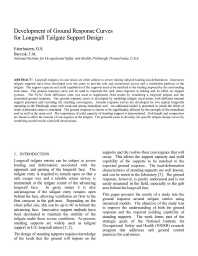Mining Publication: Development of Ground Response Curves for Longwall Tailgate Support Design
Original creation date: June 2006
Longwall tailgates in coal mines are often subject to severe mining-induced loading and deformation. Innovative tailgate supports have been developed over the years to provide safe and economical access and a ventilation pathway at the tailgate. The support capacity and yield capabilities of the supports need to be matched to the loading imposed by the surrounding rock mass. The ground response curve can be used to represent the rock mass response to mining and its effect on support systems. The FLAC finite difference code was used to supplement field results by simulating a longwall tailgate and the associated ground response. The ground response curve is developed by modeling tailgate excavations with different internal support pressures and recording the resulting convergence. Ground response curves are developed for two typical longwalls operating in the Pittsburgh Seam with weak and strong immediate roof. An additional model is presented in which the effect of weak overburden strata is simulated. The ground response is shown to be significantly affected by the strength of the immediate roof as well as the main roof. The importance of yield capacity of standing support is demonstrated. Gob height and compaction are found to affect the amount of convergence in the tailgate. The potential exists to develop site-specific tailgate design curves by combining model results with field observations.
Authors: GS Esterhuizen, TM Barczak
Conference Paper - June 2006
NIOSHTIC2 Number: 20030406
Proceedings of the 41st U.S. Rock Mechanics Symposium, Golden, Colorado, June 17-21, 2006. Alexandria, VA: American Rock Mechanics Association, 2006 Jun; :1-10
See Also
- Case History of the Response of a Longwall Entry Subjected to Concentrated Horizontal Stress
- Design Methodology for Standing Secondary Roof Support in Longwall Tailgates
- Evaluation of the Impact of Standing Support on Ground Behavior in Longwall Tailgates
- A First Step in Developing Roof Support Design Criteria Based on Ground Reaction Data for Pittsburgh Seam Longwall Tailgate Support
- Ground and Standing Support Interaction in Tailgates of Western U.S.Longwall Mines Used in the Development of a Design Methodology Based on the Ground Reaction Curve
- Longwall Tailgates: The Technology for Roof Support Has Improved, but Optimization is Still Not There
- Pumpable Roof Supports: Developing Design Criteria by Measurement of the Ground Reaction Curve
- Standing Support Alternatives in Western Longwalls
- Standing Support Alternatives in Western United States Longwalls
- UDEC Modeling of an Underground Opening in a Rock Mass of Varying Quality
- Page last reviewed: 9/21/2012
- Page last updated: 9/21/2012
- Content source: National Institute for Occupational Safety and Health, Mining Program


 ShareCompartir
ShareCompartir
